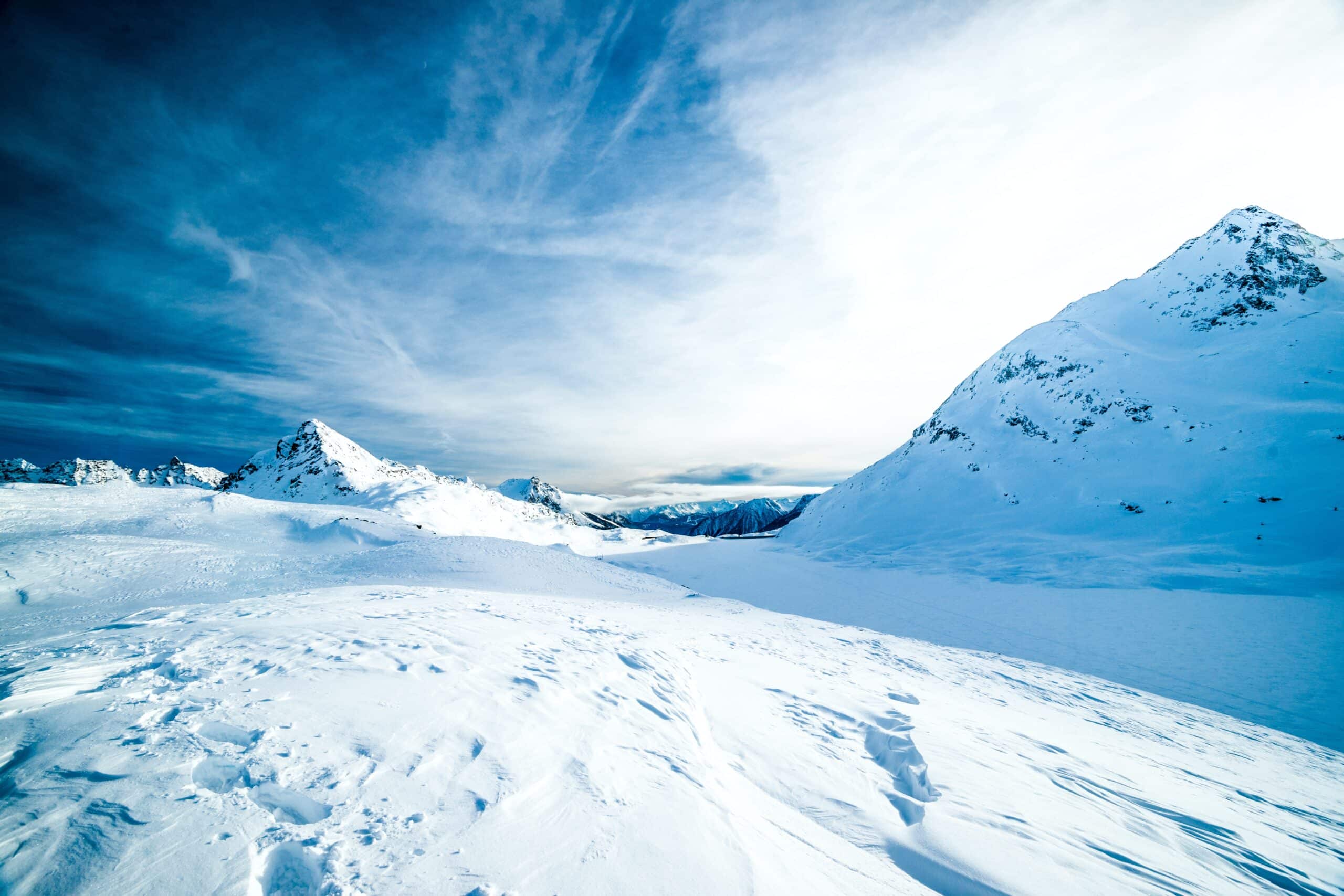Welcome to a new instalment in the series of articles about ideas for how to run adventures for Dungeons & Dragons effectively in different types of environments! Last time, we looked at mountains – and this time, we’re going even higher (or at least farther north in your fantasy realm of choice) to investigate what can be done in arctic environments, where snow, ice and iciness reign supreme. So don your snowshoes, get your furs out, and let’s plunge into the snow!

Arctic areas might not be the most common ones in fantasy adventures. On the contrary, based on my experience, a typical quest in Dungeons & Dragons takes place in a forest or a dungeon – or both. More rarely, the adventurers go chasing after treasure and trouble in mountains, on plains, or on the high seas. A mission to hunt down dragons or explore long-lost dungeons that are hidden away in a desolate region with (seemingly) nothing but snow – now that’s very rare, possibly because at a glance, such places are boring, void of hiding spaces and interesting features, and literally the opposite of colourful. But to my mind, this is something of a misconception. In fact, wintry environments can make for interesting breaks from elven forests and dim dungeons, as they come with their own unique obstacles, dangers – and wonders.
Let’s examine some aspects of arctic areas that I find intriguing and open to experimentation. Some of them are obvious, while others are more ambiguous and subtle.
It’s freezing!
While mountaintops and other locations situation high above sea level might be cool, chilly or even dangerously cold, arctic regions are really cold. Even on a good day, the temperatures should be severe enough to be lethal to unprotected adventurers who mindlessly plunge into these areas.
On a bad day, it should be far worse. We’re talking punishing blizzards, howling gales, waist-deep snow and a murderously low temperature, all taken to such extremes that merely travelling a single mile might spend the end of even the most hardened barbarian. Note that it’s enough to have just a few such days to raise tension, because the players will spend the good days fretting about the possibility of another bad one.
Coldness is possibly the problem with arctics that one thinks of first, so the question remains: how to make the cold more than just a piece of narration and a handful of Constitution saving throws? How to make the extreme temperature palpable and an essential part of the quest?
Firstly, let the cold have effects outside saves that just result in some technical limitation (a level of Exhaustion, penalties to dice checks and so on). Such complications are good and well, but they can be accompanied by other challenges such as limited lines of sight (which might result in that enemies may sneak up on the adventuring party more easily) and a decreased rate of travel (which can cause the adventurers to finish their travel rations more rapidly than expected, which in turn might force them to forage and hunt – an excellent moment to let savvy rangers or druids shine!).
There can also be more understated problems that don’t directly affects statistics of ability checks. For example, whose who wear metal armour can discover that their various metal parts end up too cold to touch without gloves, and therefore take twice as long to don or doff. Swords can glitter with a dusting of frost that makes drawing them from their scabbards unexpectedly tough and require a bonus action.
An additional way to reinforce the sense of vulnerability among the players is to underscore how monsters that are native to the area are completely unhampered by the cold – to them, is just another day, while the otherwise powerful adventurers might be struggling just to walk,
Lastly, as we’re in the world of Dungeons & Dragons, it’s perfectly fine to let brutal coldness take on a supernatural hint. After all, the arctic region that the heroes are stumbling through is probably rules by some deity who might be aware of their “guests” and wants to test their mettle. So maybe there are traces of faint evil laughter on the wind, or perhaps someone in the party spots a snowflake that’s shaped like the holy symbol of the aforementioned deity.
It’s beautiful!
Another feature of crazily cold places – at least in my view – is that they’re inherently wondrous and visually breathtaking. Simply the sight of extensive plains of untouched, powdery snow, imposing icebergs, and deep blue water between huge sheets of ice floes is almost painfully stark and enthralling through its sheer emptiness, and the harsh climate only makes this impression stronger.
But this is Dungeons & Dragons we’re dealing with, so there’s ample room for many more magical features. Everything in view can be ramped up a notch: the ice bergs can be twice the height as those on earth, icicles can be twisted into strange shapes that reflect sunlight in mysterious patterns, and the landscape can include peculiar crystalline structures made of ice that suggest the presence of other creatures or some form of omniscient power that moulds the land as it sees fit.
None of this might impact on the abilities and powers of the players’ characters, but describing the beauty of the region will help establish a feeling that the characters are far outside their usual beaten tracks.
It’s old!
There’s also something oddly ancient about arctic areas. Most likely, this is a consequence of us humans being well aware that ice can preserve items (and creatures) for tremendously long periods of time. This can be used to great effect when running a D&D adventure if you seek to establish that the area has seen activity for a long time and is filled with traces of bygone civilizations – but rather than weathered and overgrown ruins that have been reclaimed by nature, a fallen creature (or an entire village) in a place where the temperature is freezing at all times can be perfectly conserved, perhaps even inside an immensely large block of ice. Such discoveries are naturally freaky and can unnerve players, especially if they suspect that the creatures might become animated again. It’s a classic “are they dead or not” situation mixed with a sense of awe and otherness.
And the players are right in being worried! In difference to the Arctic and the Antarctic, anything that gets trapped in ice in Dungeons & Dragons might not cease to live. There can be monsters and other beings that have been encased in ice for millennia only to thaw or break free when the adventurers happen to be walking past or camp nearby. As a result, the old saying “What’s buried in snow…” can be used to full effect in in the game.
It’s massive!
Traditionally, the mention of arctic regions evokes images of mind-bogglingly huge spaces that stretch into and far beyond the horizon. Combined with their many obstacles – slippery ice, cracks in the ground, icebergs with steep scarps, open water that’s far too cold to swim, and thick coatings of snow – that slow down movement, the arctics easily give rise to an impression of pure vastness. A group of Dungeons & Dragons characters, who lack spells and other means (sleighs, skis and so on) for fast travel, will find that they must fight for every mile of their journey.
Importantly, these places can also be deep, especially as the fantasy versions of these locations can be tweaked but still remaining believable. This means that all icebergs or glaciers can hide enormous dungeons that are unlike any other one they’ve seen before – natural or artificial complexes filled with novel threats and creatures – and treasure.
It’s alive!
An arctic region might look lifeless, but many are not – especially not if it’s part of a Dungeons & Dragons setting! A quick look in the Monster Manual shows that there’s a wealth of creatures that inhabit arctic regions, and many more cold-loving beasts and critters have been added in subsequent modules and adventures for Dungeons & Dragons. What’s more, the internet is heaving with additional homebrewed monsters that live and prosper (and hunt struggling adventurers) in snowy places.
A few classic monsters include yetis, and there are probably some players who would feel like they’ve missed something unless they meet one of these legendary furry figures. There are also elementals, which might be present for natural (well, naturally magic) reasons, or they could be around because they slipped through a portal from the place of ice or were summoned by a magic user, and have found a way to linger. White dragons are also perfectly at home in these places, and these expert hunters might make the lives of the would-be heroes mightily hard as these dragons excel at making best possible use of the terrain.
It’s weird!
There’s something otherworldly about towering icebergs and vast snowy plains. H.P. Lovecraft used this environment as a backdrop in The Mountains of Madness for a reason: when travelling through such places, it’s easy to believe that one has been transported to a different, alien and rather hostile place, populated by beings that are utterly incomprehensible to the human mind.
In Dungeons & Dragons, this might be quite true! Looking at places as extreme as arctic regions, it makes sense that there might be truly strange and perilous beings around as these would match the environment. In this sense, a realm characterised by raw coldness and endless snow is as mysterious and open to imaginative ideas as any dungeon. Perhaps such eerily strange landscapes hide portals to places that are situated beyond even the outer planes, where reality and logic breaks down into an endless nightmarish turmoil, and where one might find horrific entities that crave the reason and flesh of mortal creatures the same way one hankers for a pizza after a day-long trek through a steaming forest. The mere glimpse of such places might scorch a regular person’s sanity in an eyeblink!
Such hellscapes are a sharp contrast to the uncanny quiet (baying gales aside) of apparently desolate arctic locations – but it’s exactly that contrast that amplifies their eeriness. One moment, there’s only snow and more snow, then the adventurers come across the frozen corpse of a gargantuan creature so bizarre that it defies belief. Where did it come from? Are there more of them around? Could it still be alive? Encounters of this kind don’t require any initiative rolls to instil a sense of wonder tinged with dread in the players.
Those were a few aspects of arctic locations within D&D settings that can be used to highlight their innate sense of otherworldliness and lethality. But there are many more features of realms filled with snow and ice that can be utilised to heighten their atmosphere – only the imagination determines the limits. And remember that in Dungeons & Dragons, ancient glaciers and towering icebergs can hide the most unexpected surprises!







